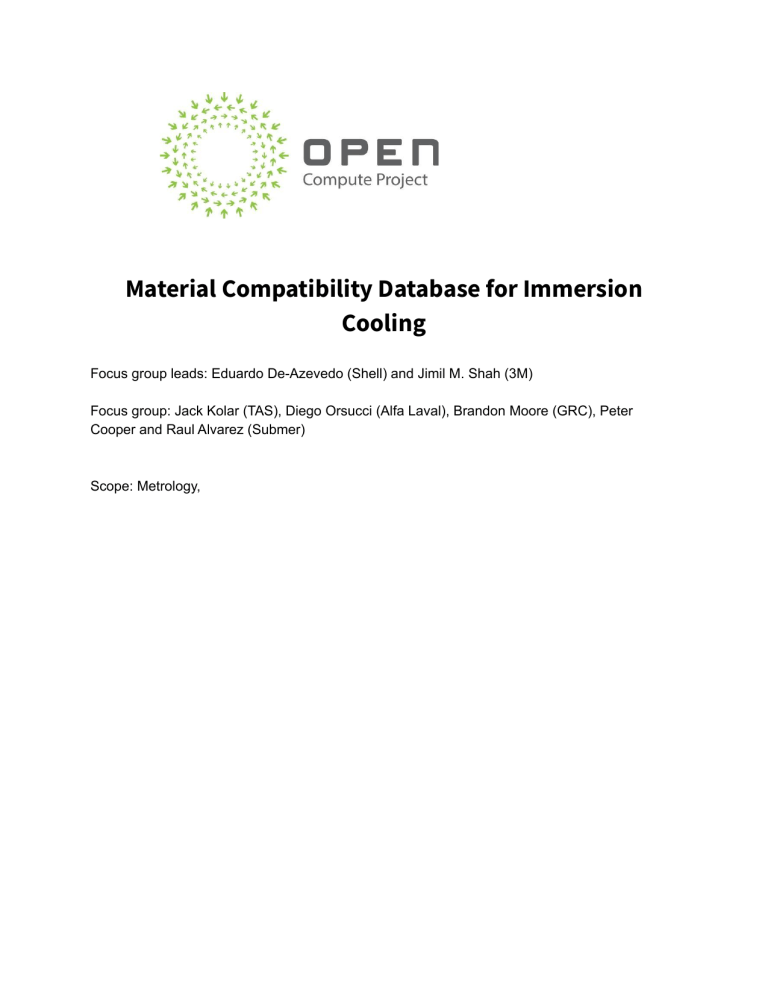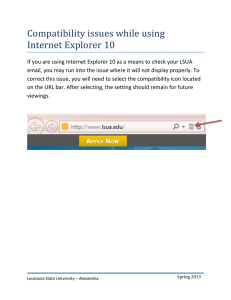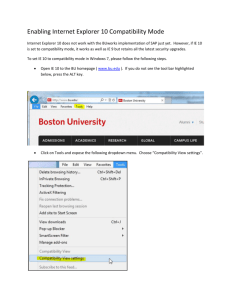
Material Compatibility Database for Immersion Cooling Focus group leads: Eduardo De-Azevedo (Shell) and Jimil M. Shah (3M) Focus group: Jack Kolar (TAS), Diego Orsucci (Alfa Laval), Brandon Moore (GRC), Peter Cooper and Raul Alvarez (Submer) Scope: Metrology, Copyright info Permissions for use of images to be covered. Executive Summary Immersion Cooling is a workstream in the Open Compute Project (OCP) Advanced Cooling Solutions (ACS) subproject under the Rack & Power Project. Immersing computing and network equipment in dielectric hydrocarbon or fluorocarbon fluids provides an efficient operating temperature environment and greatly reduces the cost and space for temperature controlling components. In addition, immersion also reduces the energy consumption necessary to operate the equipment. This document describes the chief engineering concerns of immersion and how development and manufacturing teams can tackle them. Abstract Material compatibility of the components in the immersion cooling applications is a complex topic and becoming one of the most important subjects due the intrinsic relation between the fluid and the immersed IT parts. Independently if the liquid is hydrocarbon or fluorocarbon based, awareness of this topic must be created in order to improve reliability, understand the failure modes, keep the equipment operating properly and avoid any unexpected events related to compatibility along the IT equipment designed operational life time. The Material Compatibility Database for Immersion Cooling will not only help OEM suppliers and customers to understand better the relation of the fluids with the components, but is also aiming to standardize the main compatibility test procedures adopted by the industry by collaborating and exchanging experience good practices with hydrocarbon and fluorocarbon liquid suppliers, OEMs and integrators. and final customers on their expectation. Definitions 1. Defining material compatibility for Hydrocarbons - Eduardo, Sayan and Kevin (Esters), Raul and Peter 2. Material screening list - Rick M. - Submer, GRC pending Update 26.01: Peter will provide info. Challenge with ASTM D3455 temperature. Rick M: Applications where fluid reach 95°C higher end. Collecting what is available in the marketing for now, then focus on the standard ACT: Jimil and Eduardo to finalise the format by next call Feb 2nd 3. Defining the server and wettability list - Rolf, Raul, John, Sean, Jessica 4. Standardizing the test methods - Independently - Components Vs System - All 5. List of the existing standards - Jimil, Eduardo, Raul, Sayan Notes from previous meetings: What should the database look like? What is the content? - Have some kind of matrix. Check boxes of compatibility. Reflect ideas of the market. Have a view of multiple coolants Major components or specific materials? Need to address both Several categories Typical materials found in the system. Parallel to the white paper Need to be impartial and inclusive Should talk about the physics, teach and explain the methods Win the trust of the suppliers Reference database to select components compatible for immersion specifically and supported by the manufacturer Reference for OEMs Include existing materials? Don’t think the database can be exhaustive Cross impact among the components should be addressed Comprehensive view of all compatibility issues Educating and making sure the methodologies are in place System level challenges? Tank manufacturer has filtration Approve “grading” for material compatibility Teach manufacturers “how to fish” define terms: non-recommended, acceptable, recommended, approved / certified define testing procedures and results that allow to confirm different levels define materials groups Next steps: - Request people to be part of a focus group (doesn’t have to be public ie not OCP) action by Jimil and Eduardo Jimil to send what he wants to send and Rolf can introduce Finalise Whitepaper (editorial review then approved by OCP incubation committee) Invitation to review whitepaper Nigel to share doc with group (which doc?) Can corporate Google accounts be arranged? To edit the Google docs Contact details Jimil: jshah2@mmm.com Eduardo:'E.De-Azevedo@shell.com OCP-ACS-Immersion-Cooling@OCP-All.groups.io Input for later discussion in regards to material compatibility: a) example of testing procedure b) basic material compatibility table divided per application (hoses / cables / insulating materials / gaskets). Engineered fluids did and published that some time ago https://www.engineeredfluids.com/material-compatibility - good starting point. Water-Cooled Servers doc: http://tc0909.ashraetcs.org/documents/ASHRAE_TC0909_Water_Cooled_Servers_15_Oct_201 9.pdf Objectives: 1. Frame of reference for validating the components 2. Test definitions - globally accepted test methods - existing test methods and/or modified and/or new methods 3. Database of tested equipements - important for design the system 4. Material compatibility related to different fluids - Groups of the fluids and group of the components 5. Major fluids being used for immersion cooling and different solution available in the market, e.g. Single- and Two-phase clamshell and tank style cooling with different heat transfer modes. Natural-forced and nucleate boiling convective modes. Questions: 11/03/2020 Notes: Fluid classification proposal by Peter Cooper: The goal of the compatibility database is a noble one and I am sure that we can all agree on the value of that for end users. However, given that: 1. Grouping immersion cooling fluids simplistic categories is both convoluted (Do we separate esters from synthetic hydrocarbons? Do we divide esters further still into categories? What about silicone oils?) and, worse still, misleading to end-users (how do you categorise a mixed base fluid?). 2. There is a serious conflict of interest in relying on data provided by individual fluid suppliers with no practical likelihood of checks and balances. I think we are in serious danger of doing more harm than good. To resolve this I propose the following: · A simple grouping of fluids into "hydrocarbons" and "fluorocarbons". · Generalised compatibility data for each category as agreed upon by the community (i.e. multiple inputs from different parts of the community). · For specific materials compatibility data, the end user should rely on data provided by the fluid supplier. If the need arises, additional tests may be performed by the end user as per the test method agreed upon by this OCP group. The assumptions here are: · Hydrocarbons generally show the same compatibility behaviour. · Fluorocarbons generally show the same compatibility behaviour. · Fluids that do not fall neatly into either of these categories (e.g. silicone oils) are not significantly common enough in immersion cooling to warrant an additional category. 12/1/2020 Next call agenda would be: 1. Update on Material compatibility database panel during the OCP tech week and feedback 2. Discussion on the some of the questions answered by the panelists 3. Material compatibility list update by Rick Margerison. 4. Defining and delegating the work/data packages 1. There are new classes of fluids that are coming into the datacentre immersion cooling sector and some are being represented at OCP too. So would it be useful for you (the end-users - Husam Alissa, Rob Curtis) to have these new fluids chemistries included in the document too? [Rob] Absolutely, new fluids need to be included but there’s maybe a prioritization that could be done to ensure that the fluids that are most popular or most likely to be deployed in the short term are analysed and documented first. It seems like there is an opportunity for a standard test suite to be created so that all fluid vendors are following the same fluid/material characterization process à that would allow each fluid vendor to provide the compatibility information for their fluid as soon as it is available in the market. 2. What level or depth of information would you (the end-users Husam and Rob) like to see in the document? Is a simplified, generalised document OR a detailed document, would actually be useful as a good material compatibility reference? - this question applies to both components/materials used and fluid classes. [Rob] I don’t think it has to be too complex. I think the following information would be critical though: ● Matrix of fluids and materials – highlighting what materials are compatible or incompatible with the different fluids. ● Known issues – for incompatible fluid/material combinations what is the issue? This would be useful in situations where problems are found, to more quickly root-cause the issue. Timescales typically required for any material/fluid interaction to present itself ● Test methodology – description of test methodology used to determine fluid and material interaction – e.g. Soxhlet extraction, since these are not yet common to the IT industry ● Guidelines for filtering – as Phil pointed out, filtering can completely eliminate the material to material interactions to the point that compatibility testing is then reduced to determining how each material behaves with each fluid (i.e. no material to material interactions). But the filtering requirements need to be detailed for each fluid chemistry. 6. Defining material compatibility for Fluorochemicals - Jimil 7. Defining material compatibility for Hydrocarbons - Eduardo, Sayan and Kevin (Esters), Raul and Peter 8. Material screening list - Rick M. - Submer, GRC pending 9. Defining the server and wettability list - Rolf, Raul, John, Sean, Jessica 10. Standardizing the test methods - Independently - Components Vs System - All 11. List of the existing standards - Jimil, Eduardo, Raul, Sayan 02/09/2021 Meeting Agenda: 1. Material Compatibility Focus Group Gantt Chart 2. OCP Webinar 3. White Paper Format


